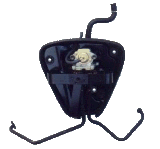
PAIR VALVE: That five pound ugly chromed box thingie that hides those gorgeous Boulevard/Intruder/Marauder/Volusia Jugs!!

The Pair Valve, or "Secondary Air System" is a pollution control "Passive Air Injection" device, designed to "wash out" the purposely rich exhaust of the new metric bikes in order to pass EPA restrictions for import in the United States and other countries with similar restrictions. Many foreign designated models do not even come with a pair valve, although all other aspects of the bike's engine are the same. (The triangular (or oval) box is a tool box on most foreign models)
The sole purpose for the Pair Valve is to passively "Inject" fresh air into the exhaust system at the exhaust port, to cause ignition of unburned fuel vapor *before* it leaves the exhaust pipes, or to thin out the mixture with enough air to fool the sniffer machines. Unburned fuel vapors enter the exhaust system whenever you back off the throttle, or gear down. When you close the throttle, as in gearing down or slowing down, the drop in vacuum at the intake port allows the Pair Valve to relax and open and allow air from the air filter box to be "siphoned" into the exhaust port by the negative pressure at the exhaust ports. (there are reed valves in the pair valve to prevent backflow from the exhaust to enter the pair valve and airbox during roll-on and subsequent positive exhaust port pressure).
On the rare occasions that the pair system is working as designed, there is no erratic popping or gurgling in the exhaust system. There should be either no additional sound at all, or a steady "afterburn" effect, similar to an eighteen wheeler's "Jake Brake", a compression release speed reducer for large trucks.
Many people who have replaced their exhaust system with louder, lower backpressure pipes, have experienced an increase in the rapid popping/gurgling noises when throttling back and gearing down. With less backpressure, the exhaust vapors tend to load up in the system, and ignition of these vapors is sporadic and annoying. This popping occurs further down in the pipes, and is louder because of more open baffles, or no baffles at all. The quick fix for this is to simply "plug up" the air tubes that go into the cylinder walls, thereby preventing the air from getting there in the first place, thus, no "in-the-pipe" ignition. You may still experience some occasional popping, set off by the intense heat, but it is much less frequent.
Removing or disabling the Pair Valve will have no
ill effects whatsoever to the bike even if its is still stock. The pair valve
system will likely clog with carbon after a year or so,
and quit working anyway.
Removal is simple, and will take less than an hour once you have
all the "stuff" together.
The presence or absence of the Pair Valve does not affect your
fuel mileage, power, or general engine running condition. It's
purpose is solely to thin out the exhaust mixture so that it will
pass all available emission control standards, and this "thinning
out" occurs at the exhaust ports *after* the pistons and
spark plugs have done their job.
If you completely remove the Pair Valve from the
bike, two air inlet holes will be left in the cylinder casings
that must be blocked off with solid plates, an airbox outlet
nipple (LC Models) and a vacuum nipple that must be capped, and
if you choose to remove the chrome Pair Valve Housing box, there
will be three 6 mm screw holes that should be filled, to give a
finished appearance to the engine.
MOST OFTEN ASKED QUESTION:
"After removing my pair
valve, I am still experiencing that annoying "popping"
upon deceleration. Did I do something wrong?
Leaking header joints, and pair valves are both causes for
ignition of fuel vapors upon deceleration, as well as an
improperly low idle speed, or improperly adjusted idle mixture.
First and foremost, make sure that your header nuts and bolts are
tight, so there is no air leakage at the header gasket.
A very common issue with the LC is its tendency to let its idle
speed "wander" a bit over a period of time. If it
"wanders" down, you'll get the popping and gurgling on
deceleration, and/or if the idle mixture is not right, you can
still get it. AND, if everything is perfect, you're still going
to get some popping. It's the nature of the beast. Big Bore V-Twins
have never been efficient at complete combustion of their fuel
mixture, and when you add in a second carburetor, you just get
twice the inefficiency. Simple heat from within the exhaust
system will still occasionally cause the ignition and thus, the
noise.
The less backpressure from the exhaust system, the more air can
climb in from the back side and feed the fumes enough to cause
the proper mixture for exhaust ignition, so that's pretty much a
given for the aftermarket pipes.
Here's what you need to do: when you are out riding, and you are
getting the popping quite frequently when backing off, reach down
and adjust your idle speed up just enough so that you can tell
you've increased it (only takes a tiny bit), and ride some more,
and see if it makes a difference. If not, then you may have to
have your idle mixture screws adjusted a little to richen up the
fuel just a tad.
Use your "Back" button or
Click HERE
to go back